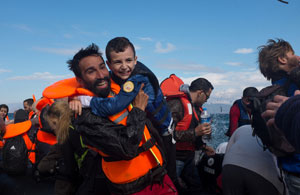The Refugee Journey to Wellbeing
July 9 – October 5, 2018

Photo © UNICEF/UNI197517/Gilbertson VII: Greece, 2015: Kadouni, laughs with the Syrian boy he is carrying ashore near the village of Skala Eressos, on the island of Lesbos. A refugee from Syria himself, he assists and welcomes refugees and migrants arriving by sea.
An immersive museum experience, The Refugee Journey to Wellbeing provides insight into refugee health and the resettlement process. The exhibit introduces visitors to the programs and processes supporting refugee health along the journey from displacement to resettlement in the United States. Its installation at the David J. Sencer CDC Museum is the first public showing of this hands-on exhibit, created in 2016 by CDC’s Division of Global Migration and Quarantine, and the Emergency Response and Recovery Branch, Division of Global Health Protection, in partnership with the American Society of Tropical Medicine and Hygiene.
The refugee experience comes alive through videos, photographs, testimonials, interactive touchscreens, and replica scenes from the field. In a theater setting through video, visitors witness the start of many refugees’ journeys toward wellbeing. Within a simulated refugee camp, visitors learn about the public health challenges in refugee settings.
Visitors then transition to a replica medical clinic illustrating the medical exams and public health interventions refugees complete as they prepare for resettlement.
Join Abbey E. Wojno, PhD, Public Health Advisor, for a special tour.
Time
12:30PM
Dates
July 18th, August 8th, August 24th, September 5th, September 14th, September 26th, October 5th
The event is free and open to the public. Reservations are required; RSVP to museum@cdc.gov.
Driver’s license or passport required for entry. Vehicle inspection required. Space is limited to 20 people per tour.
Two interactive kiosks invite visitors to test their skills at reading chest radiographs and making clinical diagnoses related to tuberculosis and parasitic infections.
In a final component of the exhibit, visitors learn about medical screenings that take place once refugees come the United States, and the importance of connecting refugees to culturally competent healthcare providers.
The Refugee Journey to Wellbeing was first displayed in November 2016 at the 65th annual meeting of the American Society of Tropical Medicine and Hygiene in Atlanta. Contributors to the effort included the US Department of State Bureau of Population, Refugees, and Migration; the Office of Refugee Resettlement within the US Department of Health and Human Services; the United Nations High Commissioner for Refugees; Médecins Sans Frontières; the International Organization for Migration; the International Rescue Committee in Atlanta; and a number of state and local public health, academic, and other nongovernmental organizations.
In 2018, The Refugee Journey to Wellbeing is organized and sponsored by the David J. Sencer CDC Museum, Office of the Associate Director of Communication; Division of Global Migration and Quarantine; and the Emergency Response and Recovery Branch, Division of Global Health Protection.
July 9 – October 5, 2018

Pam Longobardi and Susan Knippenberg, Flying Free, digital photograph, 2017
Since 2006, Atlanta-based artist Pam Longobardi has gathered and documented non-biodegradable plastics she finds in global oceans and coastal zones, utilizing these materials to produce compelling artworks. Longobardi had been working in Greece for eight years when her on-going project pivoted towards the island of Lesvos in 2015. That year, nearly 400,000 migrants landed on its shores, mostly from Syria, Afghanistan, Iraq, and Somalia. In addition to water bottles, fishing nets, and other plastic detritus that had washed ashore, there were now vast numbers of life vests and personal belongings–remnants of human migration. The result is her exhibition Crossing Over, comprised of photographs, sculptures, and installations, that speaks to one of the most challenging humanitarian crises of our times.
As a complement to The Refugee Journey to Wellbeing, Longobardi’s work is meant to provide further context to the challenges faced by both refugees and those working to address their circumstances.